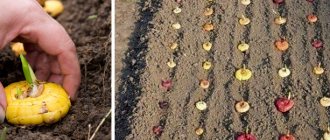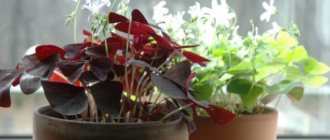general information
The evergreen perennial is a close relative of morning glory and other bindweeds. Its long, tenacious shoots grow up to 1.5 m and form a continuous carpet on any surface. In addition, dichondra also blooms in summer.
The root system matches the above-ground part - superficial and creeping. Dichondra quickly grows in breadth because its shoots self-root during growth. The small leaves resemble coins with a diameter of 0.5 to 2.5 cm.
Photo: sad6sotok.ru
Growing by seeds
When propagated by seeds, dichondra is grown by seedlings.
Dichondra seed packets
Seedlings grow very slowly, and in order to admire the emerald cascades of shoots in summer, the seeds must be sown in winter. In mid-latitudes, the optimal time for this is mid-January - early February; for northern regions, sowing dates are postponed to mid-February - early March. The seeds do not require pre-sowing treatment, and therefore you can immediately begin the main process.
Conditions for growing dichondra
Step 1. For sowing you will need small containers no more than 5 cm high.
Microgreenhouse for seedlings
A drainage layer of expanded clay or fine gravel is placed in them, then filled with soil substrate. The substrate is shed with any available growth stimulant, for example, Epin or Zircon. You can also use a humate solution.
Step 2. Seeds are evenly scattered over the surface of the substrate and lightly pressed. You can sprinkle them with a layer of earth no more than 5 mm, but this is not necessary, the seeds germinate well anyway.
Step 3. The containers are covered with polyethylene or glass and placed on the windowsill so as to prevent direct sunlight.
For dichondra seeds to germinate, a temperature within 18-25 degrees Celsius is required, so boxes cannot be placed in a cold room. On the 7-8th day, the first shoots should appear, and mass shoots appear approximately 10-14 days after sowing.
Hatched seedlings need more air, which means the film should be removed from the boxes. During this period, the seedlings are very sensitive to temperature changes, and even small drafts can destroy the seedlings. On cloudy days, lighting is definitely needed, because with a lack of lighting, the plants will begin to stretch out excessively.
Watering is done using a spray bottle and only as needed. Despite the fact that dichondra loves moisture, excess water is destructive for small seedlings. Seedlings should be thinned after the first two true leaves appear. All weak sprouts are discarded, leaving a distance of about 2-3 cm between the remaining ones. If it is a pity to throw away the seedlings, it is worth picking them all into separate pots. After this, all that remains is to maintain the optimal temperature in the room and moisten the soil in a timely manner.
For a very long time the plants will be thin and weak in appearance, but by mid-May they will grow noticeably. As a rule, the maximum decorative effect of dichondra appears 100 days after seed germination, but only under favorable conditions. When side shoots form and the plant gets stronger, you can plant it in a flower bed or in hanging baskets. The soil in the flowerbed is well loosened, holes are made for each plant separately, leaving gaps of 25-30 cm between them. The soil around the bush does not need to be compacted much, so as not to damage the roots, just pour plenty of water after planting and sprinkle with mulch.
When transplanting into pots, it should be taken into account that to create a lush crown, 4-5 seedlings must be planted in a pot with a diameter of 10 cm. If the quantity is reduced, it will not be possible to form a waterfall from the vines, and if you plant more, the roots will not have enough space and nutrients.
Recommendations for picking and forming a dense bush
Seeds are sown in open ground to create a lawn, but only in warm regions where winter temperatures do not drop below minus 3.5 degrees. The sowing process is very simple: the selected area is loosened, moistened, and then the seeds are evenly scattered. The seed consumption is 10 g per square meter. Next, the soil is rolled, watered again, and kept moist until shoots appear. You can sow throughout the entire season - from April to October. Grown-up dichondra seedlings are fed with nitrogen liquid fertilizers. This lawn is highly decorative and resistant to trampling, and tolerates shading well.
Types of dichondra
With all the variety of dichondra species in nature, gardens, on balconies and apartments, only one species is grown - a waterfall. More specifically, these two varieties!
Emerald Falls
A green variety, the size of its leaves depends entirely on the lighting. Moreover, in partial shade they grow larger. In summer, this dichondra blooms with tiny greenish flowers.
Photo: sadik-i-ogorod.ru
Silver Falls
This is the same gray dichondra with long flowing shoots. Its lashes are longer than those of the Emerald Falls, but at the same time not as lush. The variety is surprisingly unpretentious, but requires bright lighting.
Photo: domashniecvety.ru
Kobeya (50 photos): types, cultivation and proper care
Description of the flower
Dichondra is a wild plant that is quite common in Southeast Asia and South America.
. This flower loves high soil and air humidity, as well as swampy areas. However, domestic flower growers have long learned to grow it at home. In regions with a warm climate, this flower can also be grown on a personal plot. You can recognize it by the following distinctive features:
- A plant that has thin, hanging down lashes
; - The vines bear a large number of round, small, light green leaves;
- The flowers are small and inexpressive;
- Each stem has several branches, which is why the feeling of running “silver” streams of water is created.
The decorative, cultivated variety was bred by breeders relatively recently, in 2004. It was then that this plant loudly announced itself to the whole world for the first time at an international flower exhibition. In fact, she is a distant relative
the well-known bindweed (popularly called “birch”), which is very beautiful, but is traditionally considered a dangerous weed.
If favorable conditions are created for the plant, its lashes can grow from two to six meters in length. But this is only possible in those regions where summers are very long and daylight hours are long. In Russia, it is, of course, impossible to see the lashes of a flower the length of a man. But in swampy areas in Australia, Vietnam, Thailand or the Philippines, this is a fairly common picture.
Dichondra care
Dichondra is a southern resident, so all the subtleties of care are connected precisely with this. She is accustomed to the tropics and subtropics, so she needs sun, warmth and moisture.
Temperature
Comfortable temperature for dichondra is 16-26 degrees. If you bring it indoors for the winter, keep in mind that it needs a rest period at temperatures up to 15 degrees without fertilizing.
Photo: domashniecvety.ru
Lighting
For silver waterfall, lighting is a fundamentally important point, because it simply does not grow well in the shade. But the green one feels comfortable in different conditions, and only the appearance of its leaves changes.
Photo: fabrikacvetov.ru
Watering
Moderate watering and moderate humidity are very important for dichondra. Any extremes are bad here. In addition, you need to water the plant in the evening, otherwise burns may remain on the leaves. In the morning, Dichondra loves to be sprayed.
Photo: fermer.ru
The soil
Dichondra grows in almost any soil, but loam with good drainage suits it best. Let the earthen coma dry out, but not dry out. Otherwise, in the first case, the roots rot, and in the second, they die.
Photo: zooby.by
Fertilizers and fertilizing
Dichondra grows leaf mass very intensively, so nitrogen fertilizers cannot be avoided. You can alternate organic and mineral mixtures once a week.
Photo: proraboff.rf
Trimming
To form a thick and beautiful crown, it will have to be gradually trimmed. To stimulate branching, pinch the main shoots at a height of 7-8 cm.
Photo: grinagri.rf
Wintering
There are two options here. In southern latitudes, dichondra overwinters in the ground under film and leaves, and does not cause problems. And in the north it is simply grown as an annual plant, because even during the season it grows impressively. But it can be transplanted into a flowerpot together with a lump of earth and left to winter in a dark basement until spring.
Photo: domashniecvety.ru
Sedum (60 photos): types, proper care, planting and growing
What are the difficulties?
There are usually no difficulties with the “silver waterfall”, since the plant is completely unpretentious. However, in the absence of agrotechnical experience, the following difficulties may arise:
- Poor growth of foliage, which is small in size and dull in color. The reason is lack of lighting.
- Root rot occurs due to excessive watering of the soil.
- If there is not enough heat, dichondra develops too slowly.
- Lethargy of leaves - there is no irrigation of the green part of the crop.
- Curling leaves indicate a lack of soil watering.
- Stem growth and few leaves. In this case, pruning is necessary.
Dichondra (“silver waterfall”) is an exotic plant that easily adapts to our climatic conditions and soils. Therefore, it can be grown in absolutely any region of Russia as a decorative element in a room or outdoors. An important part is a careful study of agrotechnical rules, methods of propagation and sowing.
Planting and propagation of dichondra
You can grow dichondra from seeds, but it takes too long. It is easier to use layering and cuttings. The cuttings take root in water and within a week grow roots for planting in peat and sand. For greater bushiness, 3 cuttings are planted in one flowerpot. When they finally get stronger and grow up, they can be moved to the garden.
Reproduction by layering takes place directly on the ground, and often spontaneously. The shoots grow overgrown with lateral roots and quickly become established if you simply bend them to the ground and dig them in lightly. In just a couple of weeks, such layering can be planted.
Seeds are planted in the first half of winter in several pots at once to a depth of about 8 mm. They need to be moistened, covered with film and left in a bright place at 22-24 degrees. Most likely you will need phytolights.
As 2 leaves appear, the seedlings can be planted, and the film is removed when they grow to 8 cm. This is all a very long process, and its success directly depends on the temperature and lighting conditions. When the sprouts grow to 15 cm, they are transplanted to the main place. In the process, do not forget to pinch the tips of the shoots for branching.
Photo: fastbox.su
Planting in open ground
Information on the care and planting of dichondra, the photo of which is presented on this page, is given below. And now one important point: before moving a plant grown in a pot into open ground, you need to carefully inspect it for the presence of pests. Rinse it lightly under a warm shower. It doesn’t hurt to wipe the leaves with a weak soap solution - this is necessary so that they slightly stop their appearance on the still fragile tropical vine.
Next, you should take them out into the garden and place their roots in pre-prepared drained holes, sprinkle with soil and water. That's all, in the future you will only have to watch how the ampelous dichondra grows. And, of course, take care of her. In particular, it is recommended to: fertilize every 2 weeks, water, loosen the soil in the pot and remove weeds as they appear.
Pest and disease control
By its nature, dichondra is an ordinary weed, so it is not affected by pests and diseases. The only parasite that poses a serious threat is nematodes, which are difficult to notice and useless to fight. If the problem has already been discovered, such plants need to be removed quickly, the soil should be disinfected and nothing should be planted in this place in the near future.
Photo: 1poin.com
Gladioli (50 photos): types, proper care and cultivation
Open pie in the oven
Dough ingredients
- 200 g potatoes
- 200 g flour
- 1 egg
- 50 g butter
- salt
Filling ingredients
- 500 g pork or minced pork
- 2 bell peppers
- 1 tomato
- 2 small onions
- 100 ml milk (into filling)
- 2 eggs (in filling)
- salt, pepper to taste
- a little grated cheese
Preparation
Peel the potatoes and boil in salted water.
Add the egg and butter to the potatoes, add flour and knead the dough. If it sticks too much to your hands, add a little more flour. Spread the potato dough into the greased pan, forming high sides.
Lightly fry the meat or minced meat, add onions, tomatoes and bell peppers, diced. Fry for a few more minutes. Place the resulting filling on the dough.
Beat 2 eggs with milk, add salt and pepper to taste. Pour this mixture over the pie.
Place the product in the oven for 40 minutes, bake at 200°C. 10 minutes before ready, sprinkle with grated cheese.
The beauty is that the filling in this pie can be varied to suit your taste: mushrooms, chicken, smoked sausages, corn... Once you prepare this dish, you will bake it again and again to the delight of your family and guests!
Dichondra – photo
Dichondra can be used in a very original way to decorate a site and in various landscape compositions. Catch the most beautiful and original ideas!
Photo: rossoshru.ru
Photo: pocvetam.ru
Photo: id.designideashome.com
Photo: oir.mobi
Photo: instagram.com Photo: pibig.info
Photo: pinterest.ru
Photo: urban-land.ru
Photo: 2110658.ru
Photo: commons.m.wikimedia.org
Photo: fastbox.su
Photo: proraboff.rf
Photo: proraboff.rf
Photo: pinterest.ru
Photo: fermilon.ru
Photo: pocvetam.ru Photo: gardening-forums.com
Photo: komnatnyecvety.ru Photo: nz-david.blogspot.com
Photo: distano.ru
Photo: distano.ru
Photo: krsk.au.ru Photo: rastenieinfo.ru
Did you like the post? Subscribe to our channel in Yandex.Zen, it really helps us in our development!











